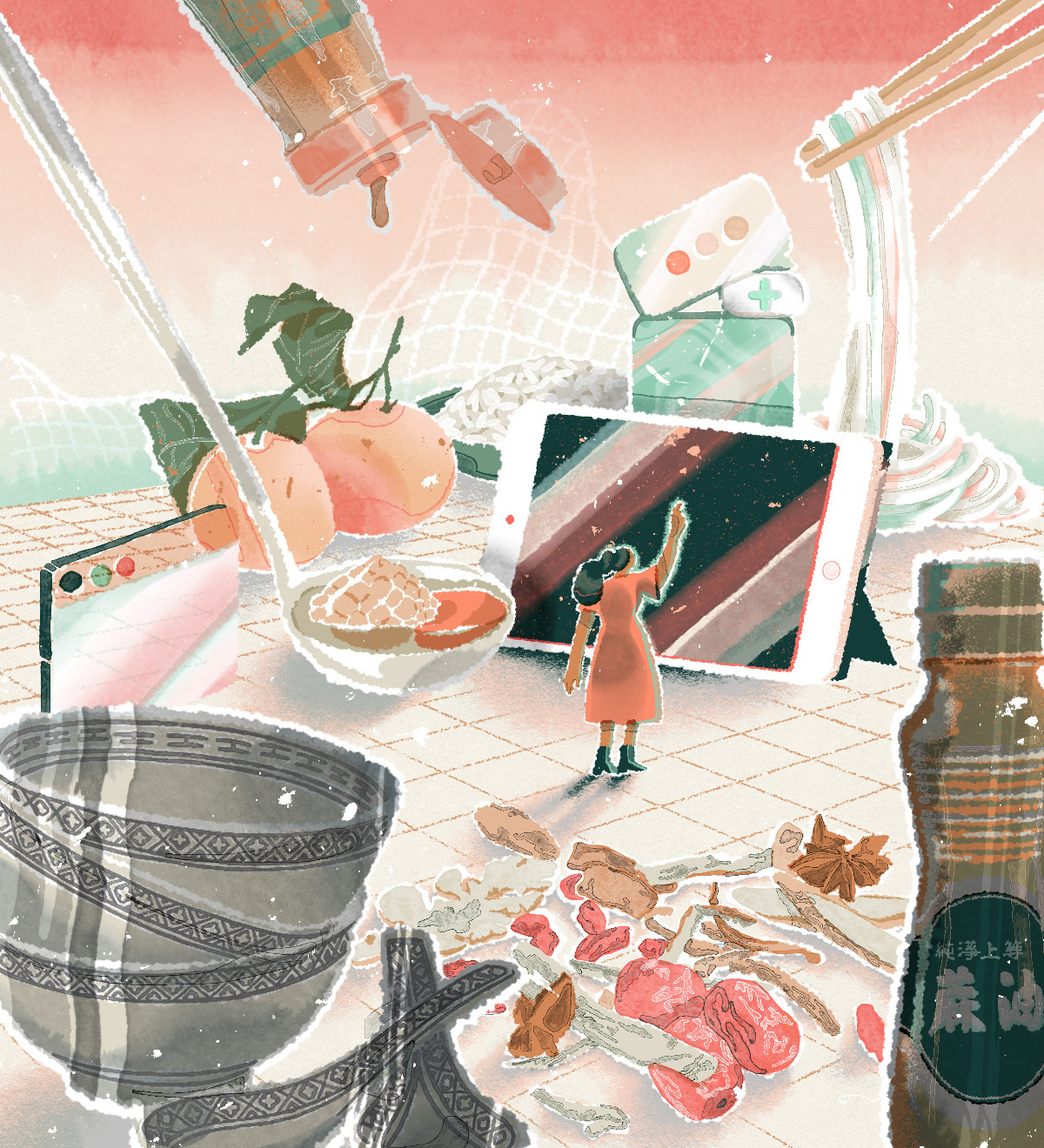When I was a kid, my mom and I would get up early every Saturday morning for the garage sales in our inner-city Calgary neighbourhood. Both of us loved used things, so we’d spend hours scrounging through piles of old skis, camping gear, kitchen appliances, and furniture we might be able to sand down and repaint.
Listen to an audio version of this story
For more audio from The Walrus, subscribe to AMI-audio podcasts on iTunes.
At one of the garage sales, I found a well-used wooden box with floral carvings on the lid. Inside, small notches lined the sides like slots. Oh, that’s a recipe box, a woman said from behind the fold-out table, demonstrating how recipes written on cards could be placed into each slot for safekeeping and pulled out as needed. I nearly laughed out loud. Didn’t she know that recipes aren’t written down? In our house, I grew up watching my mother make everything with an eagle eye, annoying her with questions until she told me to return to the table and leave her alone. Cooking—especially the secret recipes taught by father to daughter, mother to aunty—was more of a personal guessing game, requiring a lot of trial and error to get things right.
I didn’t end up buying the recipe box for fifty cents, but I liked to imagine that the meals I grew up eating could be easily replicated from a piece of paper, one step at a time. When I eventually moved out on my own, in my twenties, I craved dishes that resembled my mother’s cooking, but I realized I didn’t know how to make any of it: not the curry goat or the beef and wood ear mushroom stew or even the stuffed tofu stir fry she would drop on our table so casually after working all day. I had only a microwave in my dorm room, and my diet instead consisted mostly of instant noodles and cheese pasta. After I graduated, I turned to food blogs in an attempt to sharpen my culinary skills, but most of them were written by white home cooks who rambled on about the amazing health benefits of ginger or the extra kick of sriracha.
My relationship to cooking was at an all-time low during the pandemic, when going back home to the family table wasn’t an option. Nothing made me feel any closer to the food I missed until one night, scrolling through Instagram’s Search and Explore page, I came across a post mentioning traditional Chinese medicine (TCM). The video, by a food creator named Alice Sun, featured a quick-cut recipe for snow fungus soup: pieces of a fat yellow mushroom sitting in a bright, clear broth, surrounded by goji berries and jujube fruits—all common ingredients in TCM.
Though I was raised to eat everything on my plate, the dishes hardest to stomach as a kid were medicinal: a black soup my mother would prepare to ward off illness or a mushroom stew that was supposed to fortify my immune system. Some second- and third-generation kids have an all too familiar lunch box moment; I often had a medicinal moment, when I rejected the TCM dishes my mother served in favour of Western remedies like Lipton noodle soup packets, ibuprofen tablets, and sugary Flintstones vitamins. It’s only now, as an adult away from home, that I’ve begun to see food as holistic: equal parts healing and comforting. And it turns out that I’m not the only one.
Over the past few years, platforms like TikTok and Instagram have become a sort of digital recipe box where generational knowledge—no longer relegated to the exclusivity of family kitchens—can be easily shared. While the presence of TCM videos on these platforms means that once elusive recipes are more accessible to those who, like me, are seeking a stronger connection to the food they dismissed growing up, it’s also helping to usher in a new era for Asian creators in the online culinary world.
Restaurants, recipe books, and cooking shows have been plagued with issues over the years, from a lack of diversity among chefs in North America’s top kitchens to cultural appropriation and the whitewashing of recipes. So perhaps it’s unsurprising that this same problematic behaviour has carried over into virtual space. Many established food media outlets reduce the complexity of recipes to one basic method in order to make them more appealing to a primarily white audience. And, while chefs like Samin Nosrat and Sohla El-Waylly have found mainstream success, they still feel like outliers. In 2020, after the racism allegations at Bon Appétit, where more than a dozen current and former staffers spoke out about how people of colour were paid less, tokenized, and regularly sidelined, it became clear just how committed the gatekeepers of the food world are to showcasing white perspectives. The gap between cooks of colour and the mainstream, it seems, remains stubbornly large.
Nonwhite cooks on platforms like TikTok and Instagram are bridging this gap. Their content helps fill a demand for culturally informed recipes that, until recently, was difficult to meet. Amid the increased stress and anxiety of the COVID-19 pandemic and the rise in anti-Asian hate crimes, it makes sense that many have sought comfort and healing in the form of the food they grew up eating. Now, some of TikTok’s most popular Asian cooks, like Chef Jon Kung or Joanne Lee Molinaro, a.k.a. The Korean Vegan, have followings that rival those of their white peers.
Alice Sun, who has over 150,000 followers on TikTok and is still building her audience, began posting TCM videos—now her most popular content—in 2020, soon after she moved back in with her parents and suddenly found herself filling in as the family cook. Her experience overlaps with my own: when Sun began cooking for herself, after college, she realized she didn’t know how to prepare the meals she had grown up eating. So she decided to learn more about Chinese cuisine and share this knowledge with others online.
Though she has found some success, attracting attention from both aspiring home cooks and advertisers, she acknowledges the limitations of platforms like Instagram and TikTok. It’s difficult to save recipe videos on TikTok to revisit later, and the quick jump-cut style popular on the platform leaves little room for the storytelling associated with a recipe—an important detail when it comes to the complex histories tied to TCM and the origins of traditional Asian dishes. But her videos are a good primer on TCM, particularly for those who want to fill in the blanks about the strange, bitter concoctions pushed on them when they were young.
Most of Sun’s recipes—from Asian pear dessert soup to spicy taro chicken—were curated from conversations with friends and family, especially her grandmother. Coming up with her recipes has also meant making many trips to TCM shops in Queens, New York, to ask questions about ingredients she wasn’t familiar with.
Traditional TCM shops, often found in Chinatowns or Asian malls, can be intimidating, particularly if you don’t speak Mandarin or Cantonese and aren’t familiar with the ingredients on display. Beatrice Au, who works as the digital marketing manager at The Herb Depot in Toronto’s Chinatown, also once felt overwhelmed in these shops but has since developed a deeper understanding of how the practices work. She learned about traditional medicine from her father, who studied to become a TCM practitioner, and she tells me some of its key pillars: viewing food as medicine, maintaining a balanced qi (or life force) through mental and physical health, and treating ailments with natural remedies like herbs, movement, and acupuncture.
A lot of common TCM ingredients are also available online, a departure from the experiences of older generations who often include a visit to the TCM shop with their weekly grocery shopping in Chinatown. The online accessibility of ingredients further demystifies these centuries-old remedies. “[TCM] can look intimidating when you’re young watching elders do it, but then, once you try it yourself, you realize you have a lot of that knowledge already,” Au says. “It empowers you to find out more about your own culture.”
A few months after discovering Sun on TikTok, I decided to attempt one of her recipes myself. It was the first time I’d ever prepared a TCM dish from scratch. I settled on an Asian pear dessert soup, which Sun promised would warm my soul and make my apartment smell good. Peeling the soft yellow skin of the pear was a slow process, and I couldn’t help but feel rewarded after I finished. I boiled a pot of water on my stovetop, mixing in cinnamon, dates, and sugar. As soon as the mixture began to simmer, it released a sweet, crisp smell. I let the soup cool, served myself, and sat down to enjoy it. The sensation was exactly what I was craving: delicate and slightly crunchy—a bowl of something I’d never had before, a new sort of medicine.




